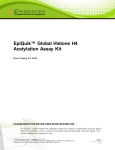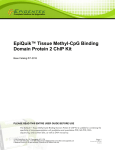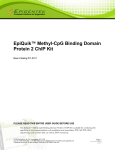Download EpiQuik™ Tissue Chromatin Immunoprecipitation Kit
Transcript
EPIGENTEK Complete Solutions for Epigenetics EpiQuik™ Tissue Chromatin Immunoprecipitation Kit Base Catalog # P-2003 PLEASE READ THIS ENTIRE USER GUIDE BEFORE USE The EpiQuik™ Tissue Chromatin Immunoprecipitation Kit is suitable for combining the specificity of immunoprecipitation with qualitative and quantitative PCR, MS-PCR, DNA sequencing, and southern blot as well as DNA microarray. Like using other ChIP kits, if you use the EpiQuik™ ChIP kits, choice of good antibody (i.e. IP proven) is required for precipitating the fixed protein/DNA complexes. 110 Bi County Blvd. Ste. 122, Farmingdale, NY 11735 Tel: 1-877-374-4368 ■ Fax: 1-718-484-3956 ■ E-mail: [email protected] ■ Web: www.epigentek.com © Epigentek Group Inc. All rights reserved. Products are for research use only. Page 1 Printed 2014-10-06 P-2003 EPIGENTEK Complete Solutions for Epigenetics KIT CONTENTS Components 24 reactions P-2003-1 48 reactions P-2003-2 96 reactions P-2003-3 CP 1 (Wash Buffer) CP 2 (Antibody Buffer) CP 3 (Lysis Buffer) CP 4 (ChIP Dilution Buffer) CP 5 (DNA Release Buffer)** CP 6 (Reverse Buffer)** CP 7 (Binding Buffer) CP 8 (Elution Buffer) 28 ml 15 ml 4 ml 4 ml 1 ml 1 ml 5 ml 0.6 ml 2 x 28 ml 30 ml 6 ml 6 ml 2 x 2 ml 2 x 2 ml 8 ml 1.2 ml 4 x 28 ml 2 x 30 ml 10 ml 10 ml 2 x 2 ml 2 x 2 ml 15 ml 2 ml Homogenizing Buffer 5 ml 10 ml 16 ml Proteinase K (10 mg/ml)* Control Primers (GAPDH) Forward (20 µM)* Reverse (20 µM)* 25 µl 50 µl 100 µl 10 µl 10 µl 15 µl 15 µl 20 µl 20 µl Protease Inhibitor Cocktail (100X)* 25 µl Normal Mouse IgG (1 mg/ml)* 10 µl Anti-RNA Polymerase II (1mg/ml)* 5 µl 8-Well Assay Strips (with Frame) 8-Well Strip Caps F-Spin Column F-Collection Tube User Guide 3 3 30 30 1 50 µl 15 µl 7 µl 6 6 50 50 1 100 µl 25 µl 11 µl 12 12 100 100 1 * Spin the solution down to the bottom prior to use. ** Extra volume is included for optimization purpose of sonication conditions, if necessary. SHIPPING & STORAGE The kit is shipped in three parts: the first and second parts at ambient room temperature and the third part on frozen ice packs at 4°C. Upon receipt: (1) Store the following components at 4°C: Protease Inhibitor Cocktail, Normal Mouse IgG, Anti-RNA Polymerase II, Proteinase K, Control Primers and 8-Well Assay Strips. (2) Store a ll other components at room temperature. The kit is stable for up to 6 months from the shipment date, when stored properly. MATERIALS REQUIRED BUT NOT SUPPLIED Variable temperature waterbath Vortex mixer Desktop centrifuge (up to 14,000 rpm) Sonicator 110 Bi County Blvd. Ste. 122, Farmingdale, NY 11735 Tel: 1-877-374-4368 ■ Fax: 1-718-484-3956 ■ E-mail: [email protected] ■ Web: www.epigentek.com © Epigentek Group Inc. All rights reserved. Products are for research use only. Page 2 Printed 2014-10-06 P-2003 EPIGENTEK Complete Solutions for Epigenetics Dounce homogener Orbital shaker Pipettes and pipette tips 1.5 ml microcentrifuge tubes 15 ml conical tube Antibody of interest for chromatin immunoprecipitation 37% formaldehyde Glycine solution TE buffer (pH 8.0) Ethanol (96-100%) GENERAL PRODUCT INFORMATION Qua lity Control: Epigentek guarantees the performance of all products in the manner described in our product instructions. Product Updates: Epigentek reserves the right to change or modify any product to enhance its performance and design. Usage Limitation: The EpiQuik™ ChIP kits are for research use only and are not intended for diagnostic or therapeutic application. Intellectual Property: The EpiQuik™ ChIP kits and method of contain proprietary technologies by Epigentek. EpiQuik™ is a trademark of Epigentek Group Inc. A BRIEF OVERVIEW Protein-DNA interaction play a critical role for cellular functions such as signal transduction, gene transcription, chromosome segregation, DNA replication and recombination, and epigenetic silencing. Identifying the genetic targets of DNA binding proteins and knowing the mechanisms of protein-DNA interaction is important for understanding cellular process. Chromatin Immunoprecipitation (ChIP) offers an advantageous tool for studying protein-DNA interactions. Unlike other methods such as EMASA, DNA microarrays, and report gene assays, which analyze direct interactions between protein and DNA in vitro, ChIP can detect that a specific protein binds to the specific sequences of a gene in living cells. A typical ChIP includes the following steps: (1) formaldehyde cross-link of chromatin; (2) shearing of chromatin; (3) immunoprecipitation; (4) reversal of cross-link; and (5) DNA purification. Requirement for using ChIP to analyze protein-DNA interaction in solid tissues and tumors is rapidly increasing. There are several methods used for chromatin immunoprecipitation, however, most of these methods available so far are very time consuming, labor intensive, low throughput, and furthermore, not specifically designed for solid tissues and tumors. 110 Bi County Blvd. Ste. 122, Farmingdale, NY 11735 Tel: 1-877-374-4368 ■ Fax: 1-718-484-3956 ■ E-mail: [email protected] ■ Web: www.epigentek.com © Epigentek Group Inc. All rights reserved. Products are for research use only. Page 3 Printed 2014-10-06 P-2003 EPIGENTEK Complete Solutions for Epigenetics The EpiQuik™ ChIP kits use a proprietary and unique procedure/composition to investigate protein-DNA interaction in solid tissues and tumors. The EpiQuik™ ChIP kit series have the following features: The fastest procedure available, which can be finished within 5 hours. Strip microplate format makes the assay flexible: manual or high throughput. Columns for DNA purification are included: save time and reduce labor. Compatible with all DNA amplification-based approaches. Simple, reliable, and consistent assay conditions. PRINCIPLE & PROCEDURE The EpiQuik™ Tissue Chromatin Immunoprecipitation Kit contains all reagents required for carrying out a successful chromatin immunoprecipitation from mammalian tissues. Particularly, this kit includes a positive control antibody (RNA polymerase II), a negative control normal mouse IgG, and GAPDH primers that can be used as a positive control to demonstrate the efficacy of the kit reagents and protocol. RNA polymerase II is considered to be enriched in the GAPDH gene promoter that is expected to be undergoing transcription in most growing mammalian cells and can be immunoprecipitated by RNA polymerase II, but not by normal mouse IgG. In this ChIP, cells are cross-linked with formaldehyde and chromatin is extracted. The chromatin is then sheared and added into the microwell immobilized with affinity antibodies. Cross-linked DNA is released from antibody-captured protein-DNA complex, reversed, and purified through the specifically designed Fast-Spin Column. Eluted DNA can be used for various down-stream applications. Schematic Procedure for Using the EpiQuik™ Tissue Chromatin Immunoprecipitation Kit 110 Bi County Blvd. Ste. 122, Farmingdale, NY 11735 Tel: 1-877-374-4368 ■ Fax: 1-718-484-3956 ■ E-mail: [email protected] ■ Web: www.epigentek.com © Epigentek Group Inc. All rights reserved. Products are for research use only. Page 4 Printed 2014-10-06 P-2003 EPIGENTEK Complete Solutions for Epigenetics PROTOCOL Note: Always cap spin columns before placing them in the microcentrifuge. Before starting, p erform the following: 1. Prepare the following required solutions (not included): 90% Ethanol; 70% Ethanol, 1.25 M Glycine Solution. 2. Ensure that all buffers are in clear solution. Shake or vortex if these buffers precipitate. Antib od y Bind ing to the Assa y Strip W ells 1. Determine the number of strip wells required. Leave these strips in the plate frame (remaining unused strips can be placed back in the bag. Seal the bag tightly and store at 4°C). Wash strip wells once with 120 µl of CP1. 2. Add 100 µl of CP2 to each well and then add the antibodies: 1 µl of Normal Mouse IgG as the negative control, 1 µl of Anti-RNA Polymerase II as the positive control, and 2-3 µg of your antibody of interest. 3. Cover the strip wells with Parafilm M and incubate at room temperature for 60-90 minutes. Meanwhile, prepare the cell extracts as described in the next steps. Tissue Disa g g reg a tion a nd In Vivo Cross-Link 1. Place the tissue sample into a 60 or 100 mm plate. Remove unwanted tissue such as fat and necrotic material from the sample. Weigh the sample and cut the sample into small pieces (1-2 mm3) with a scalpel or scissors. 2. Transfer tissue pieces to a 15 ml conical tube. Prepare the Cross-Link Solution by adding formaldehyde to culture medium (final concentration is 1%. Ex: add 270 µl of 37% formaldehyde to 10 ml of culture medium). Add 1 ml of Cross-Link Solution per every 40 mg of tissue and incubate at room temperature for 15-20 minutes on a rocking platform. 3. Add 1 ml of 1.25 M Glycine solution per every 9 ml of Cross-Link Solution, then mix and centrifuge at 800 rpm for 5 minutes. Discard the supernatant. Wash cells with 10 ml of ice-cold PBS once by centrifugation at 800 rpm for 5 minutes. Discard the supernatant. 4. Transfer tissue pieces to a Dounce homogenizer. Add 1 ml of the Homogenizing Buffer per every 200 mg of tissue and disaggregate tissue pieces by 10-20 strokes. 5. Transfer homogenized mixture to a 15 ml conical tube and centrifuge at 3000 rpm for 5 minutes at 4°C. If total mixture volume is less than 2 ml, transfer mixture to a 2 ml vial and centrifuge at 5000 rpm for 5 minutes at 4°C. Remove supernatant. Cell Lysis a nd DNA Shea ring 1. Add CP3 containing Protease Inhibitor Cocktail (PIC) (Ex: 10 µl of PIC to each 1 ml of CP3) to resuspend the disaggregated tissue pellet (100 µl/20 mg of tissue). Transfer cell suspension to a 1.5 ml vial (500 µl maximum for each vial) and incubate 10 minutes on ice and vortex occasionally. 2. Shear DNA by sonication. Usually, sonicate 4 to 5 pulses of 15 to 20 seconds each at level 2 using a Branson Microtip probe, followed by 30 to 40 seconds rest on ice between each pulse. (The conditions of cross-linked DNA shearing can be optimized based on tissues and sonicator 110 Bi County Blvd. Ste. 122, Farmingdale, NY 11735 Tel: 1-877-374-4368 ■ Fax: 1-718-484-3956 ■ E-mail: [email protected] ■ Web: www.epigentek.com © Epigentek Group Inc. All rights reserved. Products are for research use only. Page 5 Printed 2014-10-06 P-2003 EPIGENTEK Complete Solutions for Epigenetics equipment. If desired, remove 5 µl of sonicated cell lysate for agarose gel analysis. The length of sheared DNA should be between 200-1000 bp.) 3. Pellet cell debris by centrifuging at 14,000 rpm for 10 minutes at 4°C. Protein/DNA Immunop recip ita tion 1. Transfer supernatant to a 1.5 ml vial (supernatant can be stored at –80°C at this step). Dilute the required volume of supernatant with CP4 at a 1:1 ratio (ex: add 100 µl of CP4 to 100 µl of cell supernatant). 2. Remove 5 µl of the diluted supernatant to a 0.5 ml vial. Label the vial as “input DNA” and place on ice. 3. Remove the incubated antibody solution and wash the strip wells three times with 150 µl of CP2 by pipetting in and out. 4. Transfer 100 µl of the diluted supernatant to each strip well. Cover the strip wells with Parafilm M and incubate at room temperature (22-25°C) for 60-90 minutes on an orbital shaker (50-100 rpm). 5. Remove supernatant. Wash the wells with 150 µl of CP1 six times. Allow 2 minutes on an orbital shaker (100 rpm) for each wash. Wash the wells once (for 2 minutes) with 150 µl of 1X TE Buffer. Cross-Linked DNA Reversa l/DNA Purifica tion 1. Add 1 µl of Proteinase K to each 40 µl of CP5 and mix. Add 40 µl of CP5 containing Proteinase K to the samples (including the “input DNA” vial). Cover the sample wells with strip caps and incubate at 65°C in a waterbath for 15 minutes. 2. Add 40 µl of CP6 to the samples; mix, re-cover the wells with strip caps and incubate at 65°C in a waterbath for 90 minutes. Also add 40 µl of CP6 to the vial containing supernatant, labeled as “input DNA”. Mix and incubate at 65°C for 90 minutes. 3. Place a spin column into a 2 ml collection tube. Add 150 µl of CP7 to the samples and transfer mixed solution to the column. Centrifuge at 12,000 rpm for 20 seconds. 4. Add 200 µl of 70% ethanol to the column, centrifuge at 12,000 rpm for 15 seconds. Remove the column from the collection tube and discard the flowthrough. 5. Replace the column to the collection tube. Add 200 µl of 90% ethanol to the column and centrifuge at 12,000 rpm for 20 seconds. 6. Remove the column and discard the flowthrough. Replace column to the collection tube and wash the column again with 200 µl of 90% ethanol at 12,000 rpm for 35 seconds. 7. Place the column in a new 1.5 ml vial. Add 10-20 µl of CP8 directly to the filter in the column and centrifuge at 12,000 rpm for 20 seconds to elute purified DNA. DNA is now ready for use or storage at –20°C. Note: If a conventional PCR or a SYBR green real time PCR is performed, control primers (110 bp, for human tissues) included in the kit can be used as the positive control. For mouse or rat tissues, Control primers may be needed to be designed by the user. For conventional PCR, the number of PCR cycles may need to be optimized for better PCR results. 110 Bi County Blvd. Ste. 122, Farmingdale, NY 11735 Tel: 1-877-374-4368 ■ Fax: 1-718-484-3956 ■ E-mail: [email protected] ■ Web: www.epigentek.com © Epigentek Group Inc. All rights reserved. Products are for research use only. Page 6 Printed 2014-10-06 P-2003 EPIGENTEK Complete Solutions for Epigenetics TROUBLESHOOTING Little or No PCR Products 1. Insufficient amount of tissue. Increase tissue amount (ex: >10 mg of tissue/per reaction). 2. Insufficient or too much cross-linking. Check if the appropriate cross-link step is carried out according to the protocol. 3. Insufficient tissue lysis. Follow the guidelines in the protocol. Check the tissue lysis by observing a 5 µl portion of the tissue lysate under the microscope. 4. Insufficient/too much sonication. Follow the protocol instructions for obtaining the appropriate sized DNA. Keep the sample on ice during the sonication. 5. Antibody does not bind to protein. Check if the subclass or isotype of the antibody is correct. Choose an antibody that is ChIP or IP grade. 6. Incorrect temperature/insufficient time for DNA release and reversal of cross-linking. Follow the guidelines in the protocol for appropriate temperature and time. 7. Incorrect PCR conditions. Check if all PCR components are added. Increase amount of DNA added to PCR reaction. Increase the number of cycles for PCR reaction. 8. Wrong or bad primers. Ensure the designed primers are specific to the target sequence. 9. The column is not washed with 90% ethanol. Ensure that wash solution is 90% ethanol. 10. DNA is not completely passed through the filter. Increase centrifuge time to 1 minute at steps 3 to 7 of “Cross-Linked DNA Reversal/DNA Purification.” Little or No Amplification Difference Between the Positive Control a nd the Negative Control 1. Insufficient wash at each wash step. Follow the protocol for appropriate wash. 110 Bi County Blvd. Ste. 122, Farmingdale, NY 11735 Tel: 1-877-374-4368 ■ Fax: 1-718-484-3956 ■ E-mail: [email protected] ■ Web: www.epigentek.com © Epigentek Group Inc. All rights reserved. Products are for research use only. Page 7 Printed 2014-10-06 P-2003 EPIGENTEK Complete Solutions for Epigenetics 2. Positive control antibody is added into the well for the negative control by mistake. Ensure antibody is added into the correct well. 3. Too many PCR cycles. If using conventional PCR, decrease the cycles to appropriate cycle number. Differences between quantities of starting DNA can be measured generally within the linear PCR amplification phase. RELATED PRODUCTS P-2002 P-2006 P-2007 P-2008 P-2009 P-2010 P-2011 P-2015 P-2016 P-2017 P-2018 EpiQuik™ EpiQuik™ EpiQuik™ EpiQuik™ EpiQuik™ EpiQuik™ EpiQuik™ EpiQuik™ EpiQuik™ EpiQuik™ EpiQuik™ Chromatin Immunoprecipitation (ChIP) Kit Methyl-Histone H3-K9 ChIP Kit Methyl-Histone H3-K4 ChIP Kit Tissue Methyl-Histone H3-K9 ChIP Kit Tissue Methyl-Histone H3-K4 ChIP Kit Acetyl-Histone H3 ChIP Kit Acetyl-Histone H4 ChIP Kit Methyl-Histone H3-K27 ChIP Kit Tissue Methyl-Histone H3-K27 ChIP Kit Methyl-CpG Binding Domain Protein 2 ChIP Kit Tissue Methyl-CpG Binding Domain Protein 2 ChIP Kit 110 Bi County Blvd. Ste. 122, Farmingdale, NY 11735 Tel: 1-877-374-4368 ■ Fax: 1-718-484-3956 ■ E-mail: [email protected] ■ Web: www.epigentek.com © Epigentek Group Inc. All rights reserved. Products are for research use only. Page 8 Printed 2014-10-06 P-2003











